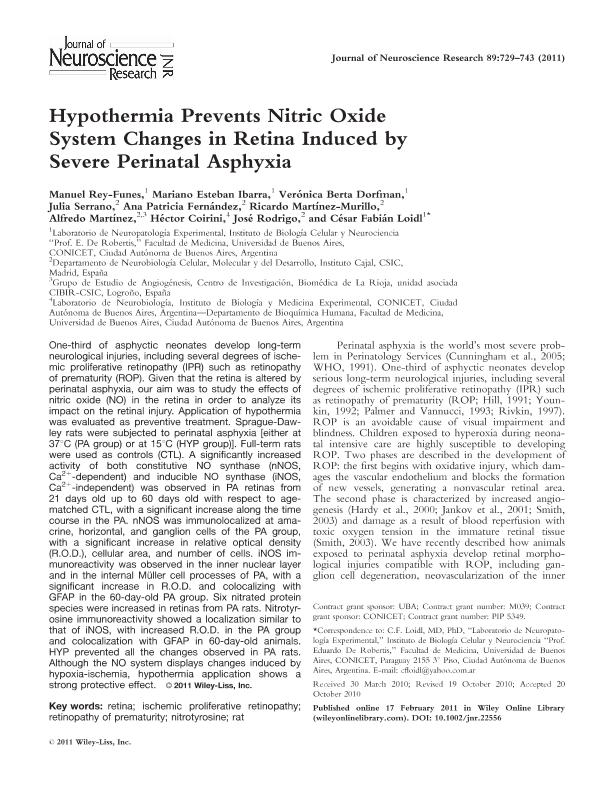Artículo
Hypothermia Prevents Nitric Oxide System Changes in Retina Induced by Severe Perinatal Asphyxia
Rey Funes, Manuel; Ibarra, Mariano Esteban; Dorfman, Verónica Berta ; Serrano, Julia; Fernández, Ana Patricia; Martínez Murillo, Ricardo; Martínez, Alfredo; Coirini, Hector
; Serrano, Julia; Fernández, Ana Patricia; Martínez Murillo, Ricardo; Martínez, Alfredo; Coirini, Hector ; Rodrigo, José; Loidl, Cesar Fabian
; Rodrigo, José; Loidl, Cesar Fabian
 ; Serrano, Julia; Fernández, Ana Patricia; Martínez Murillo, Ricardo; Martínez, Alfredo; Coirini, Hector
; Serrano, Julia; Fernández, Ana Patricia; Martínez Murillo, Ricardo; Martínez, Alfredo; Coirini, Hector ; Rodrigo, José; Loidl, Cesar Fabian
; Rodrigo, José; Loidl, Cesar Fabian
Fecha de publicación:
02/2011
Editorial:
Wiley
Revista:
Journal of Neuroscience Research
ISSN:
0360-4012
e-ISSN:
1097-4547
Idioma:
Inglés
Tipo de recurso:
Artículo publicado
Clasificación temática:
Resumen
One-third of asphyctic neonates develop long-term neurological injuries, including several degrees of ischemic proliferative retinopathy (IPR) such as retinopathy of prematurity (ROP). Given that the retina is altered by perinatal asphyxia, our aim was to study the effects of nitric oxide (NO) in the retina in order to analyze its impact on the retinal injury. Application of hypothermia was evaluated as preventive treatment. Sprague-Dawley rats were subjected to perinatal asphyxia [either at 37°C (PA group) or at 15°C (HYP group)]. Full-term rats were used as controls (CTL). A significantly increased activity of both constitutive NO synthase (nNOS, Ca2+-dependent) and inducible NO synthase (iNOS, Ca2+-independent) was observed in PA retinas from 21 days old up to 60 days old with respect to age-matched CTL, with a significant increase along the time course in the PA. nNOS was immunolocalized at amacrine, horizontal, and ganglion cells of the PA group, with a significant increase in relative optical density (R.O.D.), cellular area, and number of cells. iNOS immunoreactivity was observed in the inner nuclear layer and in the internal Müller cell processes of PA, with a significant increase in R.O.D. and colocalizing with GFAP in the 60-day-old PA group. Six nitrated protein species were increased in retinas from PA rats. Nitrotyrosine immunoreactivity showed a localization similar to that of iNOS, with increased R.O.D. in the PA group and colocalization with GFAP in 60-day-old animals. HYP prevented all the changes observed in PA rats. Although the NO system displays changes induced by hypoxia-ischemia, hypothermia application shows a strong protective effect.
Palabras clave:
Retina
,
Hypoxia-Ischemia
,
Rop
,
Nitrotyrosine
Archivos asociados
Licencia
Identificadores
Colecciones
Articulos(IBCN)
Articulos de INST.DE BIOLO.CEL.Y NEURCS."PROF.E.DE ROBERTIS"
Articulos de INST.DE BIOLO.CEL.Y NEURCS."PROF.E.DE ROBERTIS"
Articulos(IBYME)
Articulos de INST.DE BIOLOGIA Y MEDICINA EXPERIMENTAL (I)
Articulos de INST.DE BIOLOGIA Y MEDICINA EXPERIMENTAL (I)
Articulos(SEDE CENTRAL)
Articulos de SEDE CENTRAL
Articulos de SEDE CENTRAL
Citación
Rey Funes, Manuel; Ibarra, Mariano Esteban; Dorfman, Verónica Berta; Serrano, Julia; Fernández, Ana Patricia; et al.; Hypothermia Prevents Nitric Oxide System Changes in Retina Induced by Severe Perinatal Asphyxia; Wiley; Journal of Neuroscience Research; 89; 5; 2-2011; 729-743
Compartir
Altmétricas



